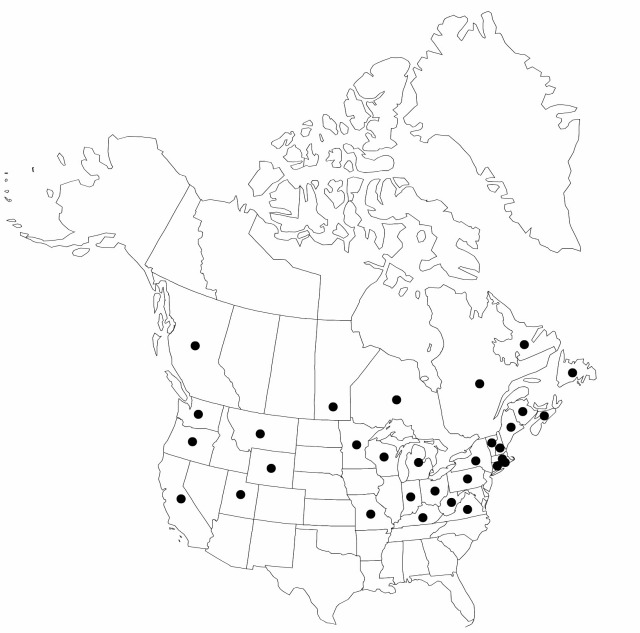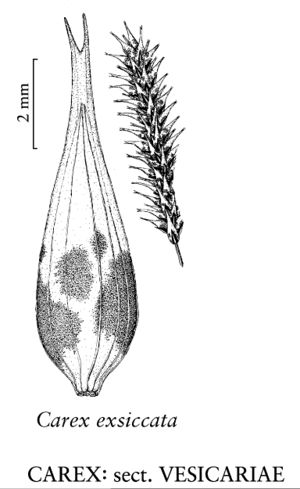Difference between revisions of "Carex vesicaria"
Sp. Pl. 2: 979. 1753.
FNA>Volume Importer |
imported>Volume Importer |
||
| (3 intermediate revisions by 2 users not shown) | |||
| Line 8: | Line 8: | ||
}} | }} | ||
|common_names=Carex vésiculeux | |common_names=Carex vésiculeux | ||
| + | |special_status={{Treatment/ID/Special_status | ||
| + | |code=F | ||
| + | |label=Illustrated | ||
| + | }} | ||
|basionyms= | |basionyms= | ||
|synonyms= | |synonyms= | ||
| Line 34: | Line 38: | ||
-->{{#Taxon: | -->{{#Taxon: | ||
name=Carex vesicaria | name=Carex vesicaria | ||
| − | |||
|authority=Linnaeus | |authority=Linnaeus | ||
|rank=species | |rank=species | ||
| Line 48: | Line 51: | ||
|publication title=Sp. Pl. | |publication title=Sp. Pl. | ||
|publication year=1753 | |publication year=1753 | ||
| − | |special status= | + | |special status=Illustrated |
| − | |source xml=https:// | + | |source xml=https://bitbucket.org/aafc-mbb/fna-data-curation/src/2e0870ddd59836b60bcf96646a41e87ea5a5943a/coarse_grained_fna_xml/V23/V23_941.xml |
|genus=Carex | |genus=Carex | ||
|section=Carex sect. Vesicariae | |section=Carex sect. Vesicariae | ||
Latest revision as of 20:44, 5 November 2020
Plants cespitose; rhizomes short. Culms trigonous in cross section, 15–105 cm, scabrous-angled distally. Leaves: basal sheaths reddish brown to reddish purple, thickened, not spongy; ligules longer than wide; blades mid to dark green, V- to W-shaped, widest leaves 1.8–6.5 mm wide, smooth. Inflorescences 7.5–45 cm; proximal bract 10–50 cm, exceeding but not more than 2.5 times longer than inflorescence; proximal 1–3 spikes pistillate, erect or the proximal ascending, ca. 20–150-flowered, cylindric; terminal 1–3 spikes staminate, well elevated beyond summit of separate pistillate spikes. Pistillate scales lanceolate to narrowly ovate, 2.4–5.8 × 1.2–1.7 mm, shorter than perigynia, margins entire, apex acute to acuminate, awnless. Perigynia ascending, often green or straw colored, 7–12-veined, veins running into beak, ovate, (3.6–) 4–7.5(–8.2) × 1.7–3.5(–4.5) mm, 2–3.5 times as long as wide, papery, apex contracted; beak distinct, 1.1–2.6 mm, bidentulate, smooth, teeth straight, 0.3–0.9 mm. Stigmas 3. Achenes yellow to pale brown, symmetric, not indented, trigonous, smooth. 2n = 70, 74, 82, 88.
Phenology: Fruiting May–Aug.
Habitat: Swamps, wet thickets, wet depressions in forests, marshes, sedge meadows, bogs, stream, pond, and lakeshores, often in sites inundated in spring and dry during summer
Elevation: 0–3300 m
Distribution

B.C., Man., N.B., Nfld. and Labr., N.S., Ont., Que., Calif., Conn., Ind., Ky., Maine, Mass., Mich., Minn., Mo., Mont., N.H., N.Y., Ohio, Oreg., Pa., R.I., Utah, Vt., Va., Wash., W.Va., Wis., Wyo., Eurasia.
Discussion
Carex vesicaria hybridizes with C. saxatilis and, very rarely, with C. hystericina and C. utriculata.
Carex vesicaria as here treated broadly as a variable circumpolar species. K. K. Mackenzie (1931–1935) recognized a small segregate, Carex raeana Boott, but specimens referred here are either depauperate C. vesicaria or hybrids. T. V. Egorova (1999) recognized C. vesicaria as a Eurasian and North American species but also recognized a primarily North American C. monile, occuring locally in Asia as well. The two species were differentiated by characteristics of perigynium length and width, pistillate spike size, and beak and beak teeth size and proportions. The North American material is so variable in perigynium size and shape and inflorescence size that recognizing the two entities seems difficult. Further study of variation in North American material and the relationships of North American and Eurasian material are needed. Indeed, the complex is in need of detailed systematic study on a worldwide scale.
Selected References
None.
